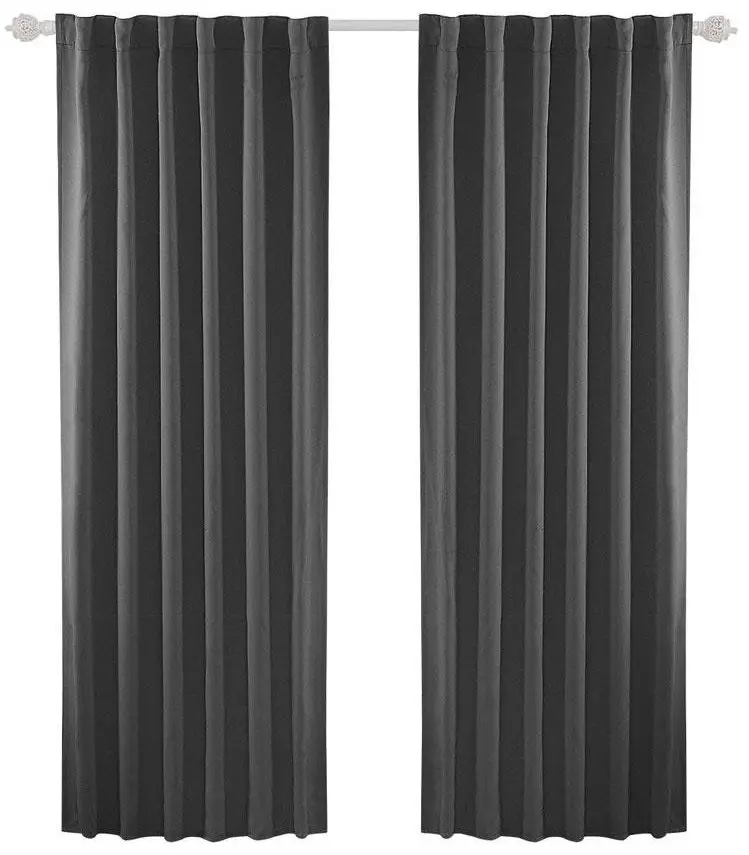Since thermal curtain balances the temperature inside a room by keeping it cool during summer and warm in winter, most people think its making process is something really complicated; when in real life, it’s nothing like that.
Just because it’s serving for something very technical, doesn’t mean you have to understand rocket science to start making one on your own. No need to go that far at all.
In fact, it’s just as easy as making lemonade. All you need to do is just squeeze and stir; we mean, sew and attach.
You might find it a little challenging if you’re totally new to this. In this case, think about people making quilt and blanket. It follows pretty much the same process.
How Thermal Curtain Works
Obviously, thermal curtain functions way differently than regular curtain, no surprise in that. You should understand that functioning process in order to make the perfect curtain.
The curtain is stuffed with insulation material and includes grommet for preventing external temperature from messing with the external thermal state of the room.
Sincerely add and sew stuff, be careful with all the materials so that they can do exactly what they should do.

Read More: How to Wash Thermal Curtains
Curtain Material
Since we’re talking about a serious issue like balancing the temperature of the house using the curtain, choice of fabric plays a pretty big role here.
Although any layer of fabric gets the job done, it’s better to go with heavyweight material because they serve for the purpose more delicately.
Also, for the external surface, you can choose from a vast collection of fabric of different colors and patterns. The choice is totally up to you.
However, we’ll suggest you not to go with something that exposes the materials inside.
How to Make Thermal Curtains ( Step By Step)
Take Measurements
Yup, before proceeding to make the actual curtain, you should finish getting some measurements first.
Now, obviously all windows don’t come in the same size and shape, so you can’t pass with any random sized curtain either. And this is more applicable when we’re talking about thermal curtains. Because the temperature’s state inside the room is going to depend on that.
So, first things first, take a scale or measuring tape and start measuring the window frame by frame.
Cut the Curtain Piece Accordingly
Remember, the curtain has to be bigger than the window.
Why? Let us explain.
In order to stop external climate from affecting the house internally, it’s important that these curtains are big enough to cover all edges of a window.
Start cutting the piece of fabric fitting the measurement you took earlier. Repeat the same process while cutting insulation material.
Moreover, keep some extra inches of fabric in the end so that you can use it later to round up the whole thing properly. Sharp measurement will cause you more trouble, as fabric will fall short when you’re done with sewing insulation material.
Prepare the Fabric by Pinning
It won’t sound weird to you if you’re not new in the sewing game. It’s challenging to sew something gigantic without keeping it stable at edges. A little bit of crease can ruin the whole sewing process for you. So, take those pins and fix the fabric’s edges.
You can also use needles as a substitute for pins.
There’s an important thing you mustn’t forget while doing so, sewing edges becomes easier when you finish sewing major part of the fabric from the inside.
That’s right, bring the internal surface out and mount it in order to start the actual work of sewing.
Take A Sewing Machine
We believe you were planning to do the same, but in case you’re wondering about taking the matter in your ‘own hands’, don’t.
Time is valuable, and we should make the best use of it. Moreover, sewing machine will do it flawlessly.
So, in order to save time and effort, use a sewing machine to get the job done.
Sew the Insulation Material In
Yes, here we are with our most essential element, the stuff that makes the big difference between a thermal curtain and a regular curtain. Insulation material is the reason why the temperature inside the room stays unaffected by the temperature outside.
As mentioned earlier, you pinned the internal surface outside, right? Now, take insulation material and sew it with the fabric.
Also, since you’re sewing the internal surface, remember that you must not sew the whole thing at once. Keep one side open and sew all the other sides. Otherwise, you won’t be able to stuff insulation materials inside.
After you’re done with sewing those internal sides, carefully pull the inside out. This way, the insulation material will get stuffed inside and the external part will be out just like they’re supposed to.
We also said earlier it’s important to keep some extra inches of insulation material just in case; now, take care of that extra part by sewing it in along with the rest of insulation material inside.
Make Holes for Grommets
We all know that internal stuffing isn’t enough for calling it the perfect thermal curtain. You have to insert those grommets as well. And for doing that, the curtain needs to have some holes in it.
Start making holes. Remember, these holes have to be of the same size, the distance between each two holes got to be similar as well. Once you’re done with it, insert the grommets to bring the balance the curtain needs.
Final Fix
After grommets, comes velcro. The curtain needs to stand steadily in its place and velcro is the thing that helps with that.
Since the velcro is going to help the curtain stay in place, you have to sew it to the back of the curtain. The side that’s not sewn has to be attached to the wall. That way the curtain will become stiff and won’t move out of places like regular curtains.
You may like to read : Best shower curtain rods

Finally, Hang the Curtain
You’ve used materials that suit your preferences. You stuffed the curtain with essential insulation material. You inserted grommet and attached velcro.
Your thermal curtain is all done and ready for use!
All you have to do now is just hang the curtain onto the rod.
This is Autem Decker. Main Author of ‘TheHomeDigs‘. You may not find her on the list of top 10 contemporary Canadian interior designers, but everyone who knows her says she was born to be an interior designer.
She makes her plan in her head and draws them in her years-old diary with a note in the corner. The way she plays with color and shape amazes us.
Connect Her On – Twitter